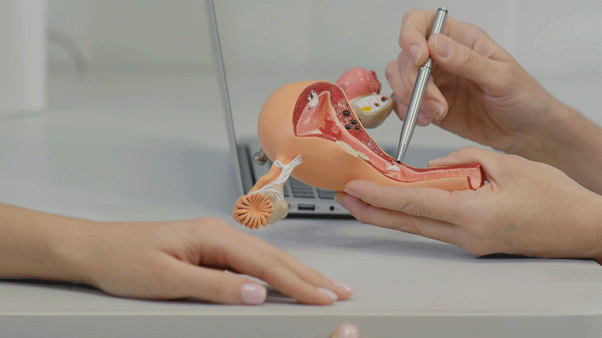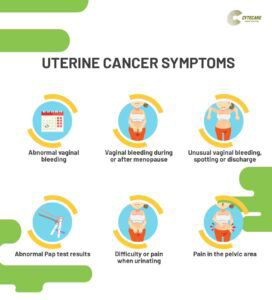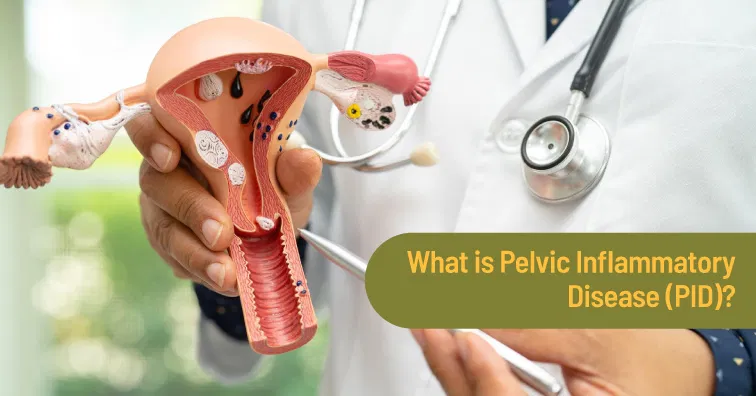
Uterine cancer is the most common cancer of a woman reproductive system which begins when healthy cells in the uterus change and grow out of control forming a tumor. It can be benign or malignant.
Noncancerous (benign) conditions of the uterus include:
- Fibroids: These are the tumors in the muscle of the uterus.
- Benign polyps: It is the abnormal growth in the lining of the uterus.
- Endometriosis: It is a condition in which endometrial tissue which lines the inside of the uterus is found on the outside of the uterus or other organs.
- Endometrial hyperplasia: It is a condition in which there is an increased number of cell and glandular structures in the uterine lining.
Major types of uterine cancer
- Adenocarcinoma: More than 80% of uterine cancer are adenocarcinoma which develops from cells in the endometrium. It is commonly called endometrial cancer.
- Sarcoma: This type of cancer develops in the supporting tissue of the uterine glands or in the uterine muscle called myometrium. It accounts for 2% to 4% of uterine cancer.
What are uterine cancer symptoms?
Sometimes women with uterine cancer do not have any, but some women may experience symptoms such as:
- Abnormal vaginal bleeding
- Vaginal bleeding during or after menopause
- Unusual vaginal bleeding, spotting or discharge
- Abnormal Pap test results
- Difficulty or pain when urinating
- Pain in the pelvic area

How Is Endometrial Cancer Diagnosis Done?
Common endometrial cancers are detected in their early stage only.
The following tests are done to diagnose uterine cancer:
- Pelvic examination: In this test, the doctor feels the uterus, vagina, ovaries, and rectum to check for any unusual findings.
- Endometrial Biopsy: It is the removal of a small amount of tissue for the examination done under a microscope.
- Dilation and curettage (D&C): It is a procedure to remove tissue samples from the uterus. It is often done in combination with a hysteroscopy so that the doctor can view the lining of the uterus during the procedure.
- Transvaginal ultrasound: It is an ultrasound which uses sound waves to create a picture of internal organs. In this, an ultrasound wand is inserted into the vagina and aimed at the uterus to obtain the pictures.
- Computed tomography (CT or CAT) scan: It creates a 3-D picture of the inside of the body using X-rays taken from different angles.
- Magnetic Resonance Imaging (MRI): It uses magnetic fields to produce detailed images of the body. It is used to measure the size of the tumor. In this, a special dye called a contrast medium is injected into a patient’s vein to create a clear picture.
If a person is diagnosed with cancer then further tests are done to categorize the stage of cancer.
What are the Stages of Uterus Cancer?
A doctor using the FIGO system assigns the stage of endometrial cancer.
- Stage I: The cancer is found only in the uterus and is not spread to other parts of the body. This stage is further categorized into two stages:
- Stage IA: In this stage, the cancer is found only in the endometrium or less than one-half of the myometrium.
- Stage IB: Cancer has spread to one-half or more of the myometrium.
- Stage II: In this stage, the tumor has spread from the uterus to the cervical stroma but not to the other parts of the body.
- Stage III: Cancer has spread beyond the uterus, but it is still only in the pelvic area. This stage is further divided into four stages:
- Stage IIIA: In this stage, cancer has spread to the serosa of the uterus, fallopian tube tissues, and ovaries but not to other parts of the body.
- Stage IIIB: The tumor has spread to the vagina or next to the uterus.
- Stage IIIC1: The tumor has spread to the regional pelvic lymph nodes.
- Stage IIIC2: The tumor has spread to the para-aortic lymph nodes but not to the regional pelvic lymph nodes.
- Stage IV: Cancer has metastasized to the rectum, bladder, and other organs. This is further divided into two stages:
- Stage IVA: The tumor has spread to the mucosa of the rectum or bladder.
- Stage IVB: Cancer has spread to lymph nodes in the groin area and the other organs such as bones or lungs.
How is uterine cancer treatment done?
Uterine cancer is treated by one or a combination of treatments such as laparoscopic surgery, radiation therapy, chemotherapy, and hormone therapy. 10-15% of patients may need adjuvant radiotherapy, and or radiotherapy with chemotherapy depending on tumor risk factors.
Surgery: It is the procedure in which the tumor and surrounding tissue are removed during an operation.
Common surgery procedures include:
- Hysterectomy: In this procedure uterus and cervix are removed with the help of laparoscopy. The surgeon may perform a simple hysterectomy or a radical hysterectomy, and for patients who have been through menopause, the surgeon will also perform a bilateral salpingo-oophorectomy in which both fallopian tubes and ovaries are removed.
- Lymphadenectomy: In this procedure lymph nodes near the tumor are removed.
- Radiation Therapy: In this procedure, high-energy X-rays or other particles are used to destroy cancer cells.
- Chemotherapy: In this procedure, drugs are used to destroy cancer cells.
- Hormone Therapy: This therapy slows the growth of certain types of uterine cancer cells that have receptors to the hormones on them.
More than 80% of cases of endometrial cancer are cured by surgery alone. The doctor will advise you to stay at the hospital for 3-5 days depending on your health.
At Cytecare, the division of gynecological-oncology is supported by state-of-the-art technology and care, which drastically improves cancer diagnosis and treatment approaches. At Cytecare, gynecological cancers are given special attention and care, and our team comprises of dedicated oncologists, gynecologist, medical oncologists, radiation oncologists, pathologists and radiation therapists who have years of experience and clinical expertise with gynecological cancer.


